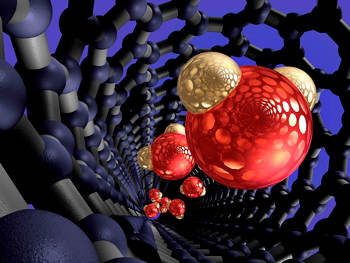Jul 7 2015
Crowd-sourced computing has helped an international research team – including researchers from the University of Sydney - discover a new method of improving water filtration systems and water quality.
The team enlisted more than 150,000 computer volunteers worldwide to conduct the research.

Together they created a network which was able to simulate water flow in carbon nanotubes at very low speeds – an activity that would normally require the equivalent of up to 40,000 years of processing power on a single computer.
The team’s discovery has been published this week in the internationally acclaimed journal Nature Nanotechnology.
The research was led by the Center for Nano and Micro Mechanics (CNMM) at Tsinghua University in Beijing, with international partners including researchers from the University of Sydney in Australia.
“Prior to our project, simulations of water flow in carbon nanotubes could only be carried out under unrealistically high flow-rate conditions”, says the Director of CNMM, Quanshui Zheng.
“Thanks to World Community Grid, the Computing for Clean Water project was able to expand these simulations to probe flow rates of just a few centimeters per second - characteristic of the working conditions of real nanotube-based filters,” the Director said.
The paper’s lead author Ming Ma, a PhD from Tsinghua University, was also a visiting scholar at the University of Sydney working with nanotechnology expert Associate Professor Luming Shen on the research. The pair commenced their work together as members of the Computing for Clean Water project.
“Computing for Clean Water, was carried out with the support of 150,000 volunteers worldwide, who contributed their own computing power to the research,” says co-author Associate Professor Shen.
“The volunteers downloaded and ran the project on their computers. The project’s results have important implications for desalination and energy conversion using salinity gradients. They can shed new light on the fundamental processes occurring in the nanoscale biological pores that funnel essential ingredients into cells.
“We also developed some key data processing methods which will become essential to analyze the massive data generated by the volunteered computers.
“By simulating water molecules flowing through nanotubes we have shown how vibrations result in oscillating friction, leading to enhancements in the rate of water diffusion of more than 300 percent. Ultimately this will help design new carbon nanotube based membranes for water filtration with reduced energy consumption.
“Crowd-sourced computing power was essential to the success of our project. I believe that crowd-sourced computing will enable more important scientific advances in cancer treatment and clean energy, for example in the future.
Associate Professor Shen explains the ongoing research. “We plan to explicitly include the effects of defects in carbon nanotubes, to use alternative methods to apply a pressure drop and to investigate other nanofluidic systems such as boron nitride nanotubes and biological channels.”